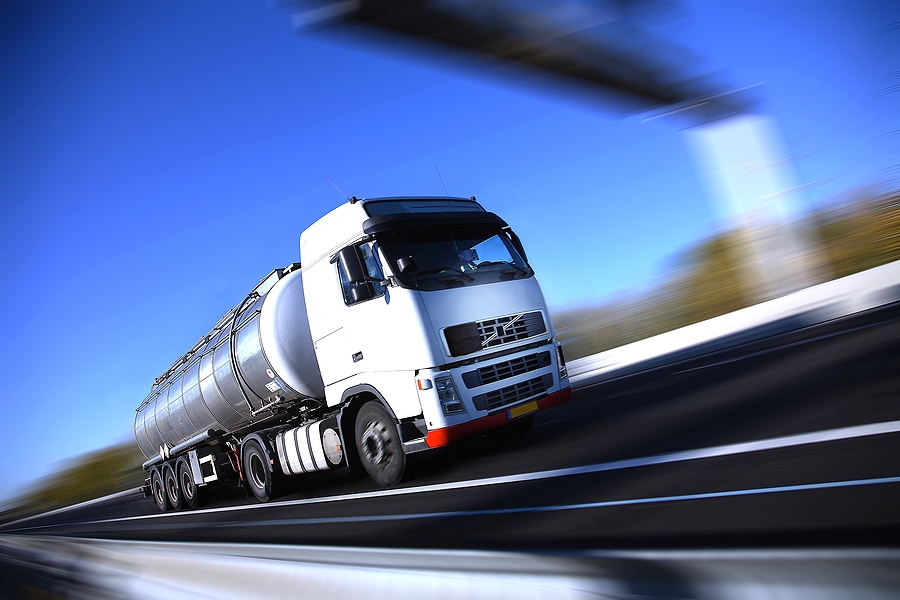Tanker trucks transport a variety of liquids and gasses across the United States. That tank can contain substances such as gas, water, liquid sugar, molasses, or industrial chemicals. As a driver traveling near a tanker truck, you may have no idea what chemicals or substances that tanker truck contains. While they offer valuable services to people across the country, they can also pose unique hazards on the road.
If you do suffer an accident with a tanker truck, an attorney can help you seek the compensation you deserve. Contact an experienced truck accident attorney as soon after your accident as possible to get a better idea of the compensation you deserve.
[lwptoc]
Common Hazards of Sharing the Road with Big Trucks
Big trucks can pose familiar hazards on the road—and tanker trucks share many of those common hazards.
Large Blind Spots
Tanker trucks, like other big trucks, have large blind spots around all four sides of the vehicle. The right side of the vehicle, which the driver cannot see down on his own, poses a particular hazard to smaller passenger vehicles. A driver can quickly lose track of smaller vehicles around him. Sometimes, this can result in sideswipe collisions when truck drivers try to change lanes without fully ensuring that they have enough space to move the truck over. Savvy drivers learn to avoid trucks’ blind spots whenever possible.
Greater Mass
Big trucks, including tanker trucks, have a much larger mass than passenger vehicles. A large tanker truck can carry up to 11,600 gallons of cargo. The weight of that cargo can vary depending on the type of liquid or gas contained within.
A tanker truck with greater mass can pose a serious hazard in an accident. Truck drivers need more room to maneuver tanker trucks than you, as the driver of a smaller passenger vehicle, need to safely turn your vehicle or bring it to a stop. If you have to make a sudden stop, change lanes abruptly, or make a fast maneuver to avoid another vehicle, a tanker truck around you might not have the capacity to make a similar move.
Tanker trucks can also pose a serious hazard during the accident. While modern vehicles have safety features that can help protect the inhabitants of those vehicles, they often do not have the structural integrity to protect against the full weight of a tanker truck. A tanker truck’s larger mass can mean more force exerted during the accident itself, which can lead to more serious injuries for all vehicle inhabitants.
Long Hours on the Road
Tanker truck drivers, like many truck drivers, spend long hours on the road each day. According to federal regulations, truck drivers can spend up to eleven hours out of a fourteen-hour shift each day on the road before they have to take a rest period. While those regulations do mandate rest stops, they do not change the long hours that many truck drivers spend behind the wheel.
Long hours behind the wheel can cause several common problems that may lead to increased challenges for those drivers and the others who share the road with them.
- Increased distraction. Because they must spend so much time driving, truck drivers often grow distracted. Some may choose to eat and drink behind the wheel instead of stopping at a restaurant for a meal, especially if they need to meet a tight deadline or need to make up time after getting stuck in traffic. While simple foods and drinks may pose little distraction, messy foods can take a driver’s attention off of the road, especially if he suffers a spill. Drivers may need to use GPS devices to navigate, especially in unfamiliar areas. Drivers may also have some distractions in the cab of the truck deliberately: books on tape, for example, can help wile away the hours on the road, but they can also take some of the driver’s cognitive attention from the road, which can pose a potent distraction.
- Road haze. Over hours on the road, each car starts to look just like all the others, and each turn in the road seems no different from all the others before it. The longer a driver spends on the road, the more likely road haze will set in. That road haze can lead to decreased awareness of the road, slowed reflexes, and difficulty safely navigating.
- Drowsiness. Many truck drivers may struggle with drowsiness behind the wheel, especially if they get back on the road after relatively minimal sleep. After spending a fourteen-hour shift on the road, drivers may need time to unwind. As a result, they may get back behind the wheel without an adequate amount of rest. Long hours on the road can also cause increasing drowsiness over time. Drowsy drivers often show many of the same symptoms as drunk drivers. They may struggle to keep their attention on the road or to maneuver their vehicles safely. Vision may decrease. In a worst-case scenario, a truck driver might fall asleep behind the wheel, leading to a serious accident because of his distraction.
- Drunk or hungover drivers. Truck drivers should not drink and drive any more than the drivers of passenger vehicles should. They control much larger vehicles and, therefore, need to have all their faculties about them when they get behind the wheel. Unfortunately, the separation from family and many of the frustrations associated with driving big trucks for a living can lead truck drivers to drink regularly: half of truck drivers interviewed admitted to drinking regularly. Others may use illegal substances. Drunk drivers may have trouble with tunnel vision or failing to notice what goes on around them. They may struggle to adequately control their vehicles. Some drunk drivers behave erratically, making it impossible for other drivers to predict their next move. For tanker truck drivers, that can represent an even more serious hazard than in drunk drivers of passenger vehicles.
Inadequate Driver Training
Every day, truck drivers help transport the majority of cargo across the United States. Big trucks transport more than trains or airplanes. They offer a highly efficient means of transporting large quantities of cargo.
Unfortunately, truck drivers have a high rate of turnover. Fleets may move new drivers in and out regularly. New drivers coming in may have relatively little experience on the road. While they undergo substantial training at truck driving school before acquiring a CDL, they do not have the real-world road experience needed to help them safely handle many of the challenges that may come up on the road, including poor weather conditions or other drivers who fail to take adequate precautions around big trucks.
Inadequate driver training can prove particularly hazardous for tanker trucks hauling hazardous chemicals, since those drivers need to exercise particular care to prevent accidents as they travel to their destination. Unfortunately, high turnover and too few employees may make it necessary for trucking companies to put drivers on those trucks who do not have the experience they need. On the road, you have no way to differentiate between a driver with a great deal of experience and one who has gotten behind the wheel of a tanker truck for the first time.
The Unique Hazards of Tanker Trucks
Tanker trucks carry many of the same hazards as other big trucks, but they also present unique hazards. A tanker truck carries a high volume of liquid cargo. That can lead to several possible hazards in an accident.
Shifting, Sloshing Cargo
Shifting cargo can cause big trucks to turn over very quickly. In a tanker truck, drivers cannot secure the cargo: that is, it naturally shifts during transport. If the tanker truck starts to shift over as the wheels slip off the road, the shifting liquid in the tank may unbalance the truck, increasing the odds that it will topple. If a tanker truck starts to shift out of control, the challenges of that liquid cargo can make it more difficult for the truck driver to bring the vehicle back under control.
Shifting, sloshing cargo can also increase risk on winding mountain roads or if the driver takes a sharp turn, especially if the driver does not recognize how that specific cargo will react and how it can impact his truck.
Potential Hazardous Chemicals
Tanker trucks haul a variety of cargo. The tanker truck beside you on the interstate could have a tank full of water, milk, or juice, or it could have a tank full of gasoline. It could also haul a variety of hazardous chemicals. In some cases, tanker truck drivers may haul several different types of cargo in the same trip. Special segmented tanks make it possible for the same tanker truck to haul more than one type of cargo, including cargo that should not necessarily combine.
Some trucks carry special warning labels to let you know that they contain hazardous or dangerous chemicals. Dangers from the cargo could include:
Chemicals that cause burns on contact. Tanker trucks may transport extremely corrosive chemicals that can cause burns on contact. Chemical burns carry many of the same symptoms as heat burns, but may cause deeper damage, especially if you do not remove the chemical source quickly. During an accident, those chemicals may spill out onto the ground, making rescue more difficult, since rescuers may need to wait for special protective gear before they can move onto the scene. In the meantime, chemical burns can cause serious complications, including scarring, infection, and trouble healing.
Chemical burns may also not cause immediate effects. In some cases, redness and swelling may develop hours after the initial exposure. You may need to carefully track your symptoms if you suffer exposure to hazardous chemicals.
Caustic chemicals that cause damage when inhaled. Sometimes, tanker trucks carry chemicals that can cause damage to the lungs when inhaled. You may find your eyes watering and burning from the moment those chemicals touch the air following an accident. If you face exposure to caustic chemicals due to a tanker truck accident, you may find yourself at high risk for ongoing health complications, including some types of cancer, lung damage, or blindness. These chemicals can cause immediate damage or damage that shows up in the hours or days following the accident. As a result, prompt medical treatment can prove critical after your accident.
Flammable or explosive chemicals. When a tanker truck dumps flammable content on the ground, it can ramp up the danger associated with recovery and offering aid. Even a small spark can cause a serious problem with flammable or explosive chemicals in the area. Rescue workers may need to work with extreme care to remove people from damaged vehicles and protect them as much as possible in the aftermath of a tanker truck accident involving flammable chemicals.
Victims of accidents involving flammable chemicals may suffer severe burns. In some cases, burns from flammable chemical accidents can lead to amputations due to the severe trauma associated with the accident.
Explosive chemicals can, of course, cause explosions, which may lead to amputations, blindness, and severe burns. The danger of explosion can complicate the rescue, especially of people trapped in their vehicles, and may make it more difficult for victims to get the help they need. Sometimes, victims may suffer more serious complications from their injuries as they wait for rescue to arrive or for rescue workers to appropriately clear the scene of the accident or don protective gear that will prevent them from facing more hazards during the rescue. Sometimes, people may die while they wait for rescue to arrive.
Slick surfaces. Tanker trucks carry liquid cargo. In an accident, that liquid cargo can spill out of the tank and get all over the rescue area. Unfortunately, that slick surface can significantly complicate rescue efforts. Slick cargo can make it hard for workers and vehicles to get down to the site of the accident, especially on difficult terrain or a strong slope.
Rescuers may need to exercise additional caution to prevent sending more vehicles sliding down the slope. Slick ground underfoot can also make it more difficult to transport wounded accident victims away from the scene of the accident.
Under-Loaded Tanks
Sending a regular truck out for a run at less than half capacity might cause a waste of fuel, but it does not usually pose an additional danger to the truck driver. In a tanker truck, however, under-filled tanks prove more likely to shift. With every turn of the wheel, the cargo moves about, increasing the danger to everyone sharing the road with the driver. Improperly filled tanks can pose a greater hazard than fully loaded tanks.
Leaks
Most tanker trucks have a strong system in place to prevent leaks and lower hazards. Nevertheless, some types of leaks can still occur. Sometimes, tanker trucks may experience serious leaks while out on the road. The truck driver might not recognize the leak, since he simply leaves a trail of liquid behind him. In the case of serious leaks, the truck driver can expose others to hazardous chemicals or leave the road behind him slick and dangerous. As the leak continues, the tank may become increasingly under-loaded, which can raise the truck driver’s risk of suffering an accident. Unfortunately, in some cases, trucking companies may encourage their drivers to push on to get as much as the cargo as possible to their intended destination, which can increase the risk of a serious accident.
How Can You Prevent Accidents with Tanker Trucks?
As a driver on the road, you may not always have the ability to prevent an accident with a tanker truck. Unfortunately, tanker truck drivers must bear a great deal of the responsibility for preventing accidents out on the road. You can, however, take several actions to help protect yourself.
1. Share the road safely.
Big trucks may seem to get in your way as you rush to your destination. That big truck, however, has the same right you do to use the road. Sometimes, big trucks need to travel at a slower rate of speed. In most cases, however, that driver has slowed to navigate the road safely: something you want him to do.
Share the road with truck drivers safely. Do not try to rush around them. If you find yourself sharing the road with a tanker truck, leave the driver plenty of room to maneuver, especially in tight conditions. The more you push, the greater the odds that you will cause a serious accident. If you need to back off to leave the truck driver room to turn or change lanes, do so. Most of the time, the tanker truck driver will appreciate your efforts, and you will usually find that it does not add significant time to your overall travel.
2. Familiarize yourself with big truck blind spots.
Take a look at the blind spots commonly found on big trucks, especially tanker trucks. Keep in mind that if the driver cannot see you in his mirrors, he has no idea where you moved. Road haze or distraction could prevent the truck driver from realizing that you have traveled beside him for the last couple of miles.
When possible, avoid hanging out in a truck’s blind spots. You can safely pass through the blind spots to get around a truck or to move with the flow of traffic, but you should not simply remain there for a long time. Instead, either speed up or drop your rate of speed so that you can get out of the way.
3. Pay attention to what tanker truck drivers do on the road.
If you share the road with a tanker truck, especially for a long time, pay attention to what that tanker truck driver does. Look for several types of behavior and respond quickly.
A tanker truck signaling to change lanes. If you notice the tanker truck’s blinker starting to flash, try to move out of the way and leave him with room to move over. A truck driver needs more room to move over than a smaller passenger vehicle. If you back off to let the tanker truck driver into your lane, signal him with a flash of your lights when he can safely move into the lane. You can often see traffic down the side of his vehicle much more easily than he can. Leave plenty of room so that he can change lanes safely.
Pay particular attention if the flow of traffic leads to you getting stuck beside a tanker truck with its turn signals flashing. If the truck driver has not recognized your presence beside the vehicle, he could try to move over on top of you, leading to a serious sideswipe collision.
A tanker truck driver behaving erratically. Do you notice signs that the driver of a tanker truck could have grown drowsy or chosen to drive while inebriated? Has the truck swerved around several times? Does the driver seem to struggle to hold a consistent rate of speed? If you notice erratic behavior in a tanker truck driver, try to remove your vehicle from the area as soon as possible.
Fall back so that you do not find yourself in range for an accident or to push far enough ahead that you no longer have a high risk of getting involved in an accident. If needed, pull off the road and call the police to let them know about the hazard. Sometimes, you may need to choose a new route to your destination to keep yourself and your passengers safer.
A tanker truck struggling to stay in its lane. Tanker trucks with cargo problems, including under-loaded tanks, may seem to shift back and forth in their lanes. They may have trouble holding the lane, especially around curves, or seem to have more trouble getting back in their lane after shifting out of it. If you notice this happening, give the tanker truck a wide berth and do not travel beside it, since sloshing cargo may make it more difficult for the driver to keep his vehicle under control.
4. Exercise particular care in poor weather conditions.
Pay attention to the weather and the unique hazards it may present for tanker trucks. In wet, rainy weather, for example, the roads may grow slick, making it more difficult for a tanker truck to stay on course. In poor weather, you may need to move your vehicle further back and allow a tanker truck more room to maneuver. Stay very alert in poor weather. Sometimes, simply keeping an eye on a tanker truck can make the difference you need to avoid an accident.
5. Signal your intentions clearly.
Tanker truck drivers know how much room they need to maneuver, and they will often react accordingly. To help them prevent accidents, make sure you clearly signal your intentions. Try not to change lanes abruptly or stop quickly. If you know you have a turn coming up very shortly, go ahead and put on your turn signal, even if you do not know exactly where you will need to turn. Truck drivers may need to slow down earlier than other passenger vehicles to avoid a collision with you.
You should also exercise care when pulling over in front of a tanker truck. Take care not to pull over in front of the truck at a stop sign or red light, where the driver might not have enough time to stop safely. Try to allow plenty of room to change lanes in front of a tanker truck. Try signaling your intention to move over as you get closer to him, then waiting for the driver to let you know that you have plenty of room to move over safely. Often, truck drivers will back off to give you more room to change lanes if they know about your intentions ahead of time.
6. Avoid distractions behind the wheel.
Distracted drivers can cause an accident in the blink of an eye. If you become distracted behind the wheel, you may have no idea what goes on around you. If you get distracted as you drive alongside a tanker truck, you may miss the signs of a pending accident or even cause an accident due to your distraction.
Instead, keep your eyes on the road, your hands on the wheel, and your attention on the drive. Paying close attention, especially when it comes to the actions of tanker trucks around you, can help reduce your risk of an accident.
What to Do if You Have an Accident With a Tanker Truck
Despite your best efforts to keep yourself and your passengers safe, you may still suffer an accident with a tanker truck. If you do find yourself in a tanker truck accident, make sure you follow the right steps to keep yourself safe.
1. Pay attention to the driver’s instructions.
If you get out of your vehicle, you could face exposure to toxic or hazardous chemicals. You may not know what the tanker truck has in its tanks, but the truck driver does. If he or she suggests moving away from the immediate scene of the accident or signals you not to come closer for any reason, listen to those instructions. Keep in mind that the driver has more knowledge than you do about what to do around those hazards.
2. Stay at the scene of the accident until the police arrive, if you can.
Never leave the scene of a tanker truck accident unless you do not feel safe there or you need to seek emergency medical care. If you must leave the accident scene, immediately contact the police and let them know where they can find you.
3. Take pictures, if you can safely do so.
Thanks to the invention of camera phones, most people now have the means to collect evidence easily at the scene of the accident. If you can safely navigate the scene of the accident, you may need to take pictures of the damage to your vehicle, the damage to the tanker truck, and any identifying information on the truck: the company name, any information about the cargo displayed outside the vehicle, and the license plate, for example. Listen to the tanker truck driver if he suggests you cannot safely move around the scene of the accident.

4. Always seek medical attention after a serious accident.
You may not believe that you suffered injury immediately after an accident, but you may find later that you suffered more serious injuries than you initially thought. Any time you have a serious accident, seek medical attention. Let your doctors and care providers know about any chemical exposure you faced as a result of your accident. You may need special treatment to help decrease your risk.
If you suffered chemical burns, you may need to have treatment based on the specific chemicals you suffered exposure to during the accident. Listen to all directions given to you by medical providers, especially if they recommend taking specific actions or avoiding certain behaviors that may increase your odds of making a full recovery. If you have severe injuries, you may require prolonged hospitalization and ongoing treatments to maximize your recovery.
5. Contact an attorney as soon after your accident as possible.
Following a serious tanker truck accident, you may need an attorney to help you pursue a truck accident claim. An attorney can help you investigate your tanker truck accident and give you a better idea of your right to compensation.
Gomez Trial Attorneys
655 West Broadway, Suite 1700
San Diego, Ca 92101
619-237-3490







